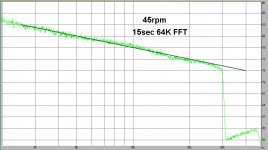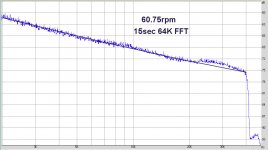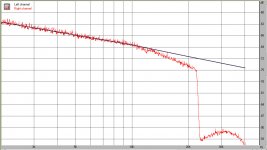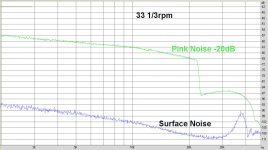Anyone encounter the Neumann Pole yet on their LPs?
If you try and correct for you you get a large drop at 20kHz.
The Neumann lathes had this pole at about 42kHz. Wyn's
pretty good at this stuff and has helped me understand what
is going on in LP land.
These and other poles, as you know inter-modulate and end up in
our audio band and gum it up good. that we don't want.
But then we can end up with the "unintentional and unwanted ZERO".
I wonder if that is how the link to the .1% distortion 1kHz because (-124dB)?
That for only $14.95USD.
The 0.0001% board is only 22.95
Then there is another for 30.94 with a trim pot in it, for the extra $8 dollars.
There is Chinese lettering in the lower right corner of the pic too.
After you get to this level, ebay determines you want something better
so links to various HP Frequency Counters, Analyzers and signal generators comes up,
asking for more money too.
Cheers,
If you try and correct for you you get a large drop at 20kHz.
The Neumann lathes had this pole at about 42kHz. Wyn's
pretty good at this stuff and has helped me understand what
is going on in LP land.
These and other poles, as you know inter-modulate and end up in
our audio band and gum it up good. that we don't want.
But then we can end up with the "unintentional and unwanted ZERO".
I wonder if that is how the link to the .1% distortion 1kHz because (-124dB)?
That for only $14.95USD.
The 0.0001% board is only 22.95
Then there is another for 30.94 with a trim pot in it, for the extra $8 dollars.
There is Chinese lettering in the lower right corner of the pic too.
After you get to this level, ebay determines you want something better
so links to various HP Frequency Counters, Analyzers and signal generators comes up,
asking for more money too.
Cheers,
I regularly intermix porn and philosophy in my audio searches on internet, so as to make the robot get off track or become a bit more creative
George
George
The FR obtained from measuring the Adjust+ LP seemed to show as if some resonance occurred between 20kHz and 30kHz.
Cartridge dynamic behaviour
In the recent measurements in #795 with the CH Precision Calibration Record, there was no sign of such resonance.
So the bump in the Adjust+ LP must have been caused by the digital noise generator, and as Chris Feickert replied, his concern was only to get things right from 20Hz to 20kHz.
So although my Cart is an MC version, I would have expected at least some resonance from the cantilever, but so far I see no sign of it.
When someone has an idea for me to dig deeper into the matter, I will be happy to try.
At the same time, I'm very anxious to see results taken with the same Calibration Record by Bill / LD.
Hans
Cartridge dynamic behaviour
In the recent measurements in #795 with the CH Precision Calibration Record, there was no sign of such resonance.
So the bump in the Adjust+ LP must have been caused by the digital noise generator, and as Chris Feickert replied, his concern was only to get things right from 20Hz to 20kHz.
So although my Cart is an MC version, I would have expected at least some resonance from the cantilever, but so far I see no sign of it.
When someone has an idea for me to dig deeper into the matter, I will be happy to try.
At the same time, I'm very anxious to see results taken with the same Calibration Record by Bill / LD.
Hans
Anyone encounter the Neumann Pole yet on their LPs?
If you try and correct for you you get a large drop at 20kHz.
The Neumann lathes had this pole at about 42kHz. Wyn's
pretty good at this stuff and has helped me understand what
is going on in LP land.
The Neumann pole lives at area 42 with Lord Lucan and the Roswell Aliens.
Area 42? Is this a new one?
Yeah - no such thing as a Neumann pole from all the research I've done on it. I believe it was Allen Wright (RIP) that first spoke about it and it took off from there.
That the cutting head amplifier is band limited should not be in question, but trying to compensate for it in the replay EQ is not a good move IMHO. Once you are beyond the audio band (> 20 kHz), you should just let things drop off gracefully.
A good test for this is a 10 kHz square wave through an inverse RIAA filter. The edges should start to show some nice rounding. If you have overshoot, your RIAA EQ is not accurate. Its a great way to test for RIAA compliance because its very sensitive to frequency anomalies at HF.
Yeah - no such thing as a Neumann pole from all the research I've done on it. I believe it was Allen Wright (RIP) that first spoke about it and it took off from there.
That the cutting head amplifier is band limited should not be in question, but trying to compensate for it in the replay EQ is not a good move IMHO. Once you are beyond the audio band (> 20 kHz), you should just let things drop off gracefully.
A good test for this is a 10 kHz square wave through an inverse RIAA filter. The edges should start to show some nice rounding. If you have overshoot, your RIAA EQ is not accurate. Its a great way to test for RIAA compliance because its very sensitive to frequency anomalies at HF.
Hans: I might expect something, but given the very light cantilever/stylus assembly and good damping it might be elusive.
The Aurak in it's basic form has a Neuman pole.The Neumann pole lives at area 42 with Lord Lucan and the Roswell Aliens.
It lives between the first and the second stage, 2K2 + 1.5nF 😀
I have checked everything again, but results with the CH-Precision record are very repeatable.
Instead of a 16K FFT, I have now used a 64k FFT to get even more detail in finding eventual resonances, but with no effect.
In all three speed versions, I have drawn a black line belonging to the -3dB/oct pink noise rol off.
This line is already corrected for the deviation of the wrong Riaa time constants when playing at 33 1/3 and 60.75rpm.
The 45rpm version is almost perfect within +/- 0.5dB.
The 60.75rpm version isn't too bad either, but showing +1dB lift at 30kHz.
But what really bothers me is the 33 1/3 version that starts going down from 10kHz at 6dB/oct instead of 3dB/oct.
I expected this to be a piece of cake playing a 45rpm record at 33 1/3 rpm, but for some reason this does not result in the expected curve.
Can anybody explain this behaviour when playing at 33 1/3 rpm ?
Hans
Instead of a 16K FFT, I have now used a 64k FFT to get even more detail in finding eventual resonances, but with no effect.
In all three speed versions, I have drawn a black line belonging to the -3dB/oct pink noise rol off.
This line is already corrected for the deviation of the wrong Riaa time constants when playing at 33 1/3 and 60.75rpm.
The 45rpm version is almost perfect within +/- 0.5dB.
The 60.75rpm version isn't too bad either, but showing +1dB lift at 30kHz.
But what really bothers me is the 33 1/3 version that starts going down from 10kHz at 6dB/oct instead of 3dB/oct.
I expected this to be a piece of cake playing a 45rpm record at 33 1/3 rpm, but for some reason this does not result in the expected curve.
Can anybody explain this behaviour when playing at 33 1/3 rpm ?
Hans
Attachments
Can anybody explain this behaviour when playing at 33 1/3 rpm ?
The plot thickens.
I suspect that the Neumann pole story became a convenient excuse for a series feedback design where the unity gain shelf came in a bit low
The plot thickens.
The 33 1/3 rpm Adjust+ LP gives a perfect image at 33 1/3 rpm.
The 45 rpm CH Precision record gives a perfect image at 45 rpm.
It is almost as if a record only performs correctly when played at the intended speed.
Just a coincidence ?
Scott,The plot thickens.
You once made a .wav filled with white noise, by starting with a flat complex conjugate spectrum and taking the inverse FFT.
This was performed with a 64K FFT.
When calculating the spectrum from the .wav file with another FFT length, the result was inferior.
Could it be that a similar situation is the case here when playing synthetically created pink noise on a different speed.
Both companies, Adjust+ and CH Precision confirmed to me that it been a hard challenge in getting things right after several attempts.
So it was obviously not just as simple as: create a noise file and put it on the record.
Fact is that the measured results do not conform to the expectation, unless played at the speed that the record was meant for.
Just another mystery ?
What's your opinion on this, thickening plots do not seem to apply.
Hans
Probably it is the inherent vinyl groove noise.
Hans, can you do the same on blank tracks?
1 check the FFT of a 45rpm blank track when played on 45rpm and on 33.3 rpm
2 check the FFT of a 33.3 rpm blank track when played on 33.3rpm and on 45rpm
George
>Edit:
Hans, can you do the same on blank tracks?
1 check the FFT of a 45rpm blank track when played on 45rpm and on 33.3 rpm
2 check the FFT of a 33.3 rpm blank track when played on 33.3rpm and on 45rpm
George
>Edit:
Well I think Scott meant it as an idiom 😀, the line thickness of your plots are indeed OKthickening plots do not seem to apply.
Well I think Scott meant it as an idiom 😀, the line thickness of your plots are indeed OK
Yes, these noise plots are like a detective mystery.
George,Probably it is the inherent vinyl groove noise.
Hans, can you do the same on blank tracks?
1 check the FFT of a 45rpm blank track when played on 45rpm and on 33.3 rpm
2 check the FFT of a 33.3 rpm blank track when played on 33.3rpm and on 45rpm
Do you suspect that surface noise plus pink noise at 45rpm together do result in a straight 3dB/oct line and that with lower rpm surface noise is lower, resulting in the roll off at 10kHz from 10kHz and a raise of the pink noise curve at 60.75rpm ?
Interesting theory, I'll see if I can find a prove for this.
Thanks for the tip.
Hans
Here is the first one.Correct Hans.
This is what I suspect is happening.
George
Pink noise at 45rpm versus 45rpm surface noise from the same record, displayed on the same scale.
As it seems, surface noise is in al cases >35dB below signal level, so I don't think it can play any role at all, do you agree ?
Hans
Attachments
Correct Hans.
This is what I suspect is happening.
George
Except RIAA pre-emphasis is there for just that reason. The sampling artifact (33 play of a 45 is essentially re-sampling at a lower frequency) is appealing but I don't see it acting the way it is. It's also worth exploring if the sinc() response correction has anything to do with this (if the noise is actually digitally generated).
Thanks Hans for the fast factual response!
The level difference wouldn’t support the scenario.
But the decisive evidence is that in both replay speeds, the surface noise btn 7kHz-30kHz drops by 6dB/oct. No change there.
So my scenario is wrong.
Question. When we have the plot of the pink noise which consists from the pink noise engraving plus the surface noise, how can we mathematically deduct the two, so that we can estimate the pink noise alone from the composite effect curve?
(I bet Scott will jump in as the sentence above contains the word “noise” at four points, so he can’t resist 🙂)
George
The level difference wouldn’t support the scenario.
But the decisive evidence is that in both replay speeds, the surface noise btn 7kHz-30kHz drops by 6dB/oct. No change there.
So my scenario is wrong.
Question. When we have the plot of the pink noise which consists from the pink noise engraving plus the surface noise, how can we mathematically deduct the two, so that we can estimate the pink noise alone from the composite effect curve?
(I bet Scott will jump in as the sentence above contains the word “noise” at four points, so he can’t resist 🙂)
George
- Status
- Not open for further replies.
- Home
- Source & Line
- Analogue Source
- Cartridge dynamic behaviour




